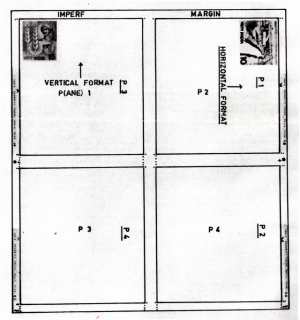PRINTERS SHEET
It is a unit of two or four panes of a printing, printed simultaneously from a single plate or a cylinder.These panes are seperated from each other in the printer's sheet by a vertical and/or a horizontal interpane gutter usually of stamp size.The marginal inscriptions are generally arranged on the peripheral margins of the panes of the printer's sheet and the interpanes gutters are usually left blank.After the sheets has passed through the perforator,the panes are guillotined through interpane gutters,trimmed and supplied to post offices for sale.These panes can be individually identified and their position in the printer's sheet determined with the help of printer's imprint,sheet makings,and perforation types.Cylinder numbers help to differentiate between consecutive printings of an issue.However,in the absence of marginal inscriptions(printer's imprint and cylinder numbers)and with certain preforation types,it is not always possible to identify all the panes of a printing and their position in the printer's sheet.

SHEET DETAILS
In the study of stamp sheets following sheet details are worthly of note:-
(a) SHEET SIZE: number of stamps per sheet is expressed as e.g.50(10x5),which means that the sheet has 50 stamps arranged in five rows of ten stamps each.
(b) MARGINAL INSCRIPTIONS: this refers to printed matter appearing on the sheet margins and may include the name of Issuing Authority,printer's name or style,plate or cylinder numbers,total sheet value etc.In this country India Security Press,Nasik(ISP)has been exclusive printers of the postage stamps since 1926 to date (with lone exception of 1948 Mahatma Gandhi stamps which were printed by Curvoisier of Geneva,Switzerland).All stamps printed by from 1947 to 1967 bore no printed matter other than sheet marketing on the sheet margins. Following the recommendations made by the Working Groups of Philatelic Seminar of 1967,ISP was obliged to inscribe its name and the plate or cylinder number of a printing on the margins of individual panes of the definitive stamps.All marginal inscriptions usually appear on the side of longer dimension of the stamps on the sheet margin,although there are exceptions to this rule also.This knowledge is very helpful in identifying the four panes of the printer's sheet.
(c)CYLINDER NUMBERS: the practice of inscribing th plate or cylinder numbers on the sheets of aprinting of definitive stamps has greatly widened the horizon of philatelic research and the study of the definitive stamps.These help the collector to follow the printing history of an issue and make note of any changes in the stamp design,size,paper,watermark,perforation types,gum and flaws retouches and re-entries in the cnsecutive printing and record them accurately in a chronological order,in terms of cylinder numbers and pane identification.Result of such studies are now incorporated in this catalogue.
In moders photogravure the 'Plate' is usually a Cylinder'in high speed multicolour rotary presses.We have,therefore,preferred to refer them as 'Cylinder'rather then the 'plate' in the text in this book.
Printers imprint(India Security Press,nasik Road)is followed by a Capital letter and a number e.g.'A5'.'A'is the designation given to a particuler denomination in the definitive series and the number denotes the succesive cylinders used for printing an issue during its currency over a period of time.
It should be noted that printer's imprint and cylinder numbersare not given in case of commemorative and definative stamps printed by offset-litho.
(d)SHEET MARKINGS: any marks found on the sheet margins are purposeful an daid or moniter some process or the other in the production of stamps.It is ,therefore,necessary to understand their significance and take advantage of them in the study of stamps.There are described below:-
(i).Marginal arrows:these are of V or W type and may be found on any or all margins of the sheet.Beside acting as an aid to post office clerks in breaking up sheets these may also act as perforation guide marks.
(ii)Marginal Rule:these are solid lines of colour bordering the stamps on the sheet margins.These are produced bt metal rule around the printing plates intended to take the shock of inking roller and prevent damage and undue wear of the printing plates.These maybe of cintinuous type without break or broken in short lengthsequal to adjacent stamps.The latter is known as 'Co-extensive type'.Their presence indicates printing by typography.
(iii) Colour codes: this term denotes a means of checking registeration of colours in two or more colour printings, and are intended as a check on missing colours. They are also helpful in a accurate recording of colour shadesused in the printing. Following types of colour codes (CC) are seen on colour, or three or more colour printings:-
(iv) Colour Registration Marks (CRM): these marks are intended as a check on correct registration of the
colours in two or more colour printings and are found in the shape of superimposed dashes, crosses or
crosses in circle as illustrated below:

Mostly seen on sheets
of two colour offset printings. |
Seen in two or more colour printings in photogravure, usually located on the same sheet margin as colour code. |
(v) Perforation Guode Marks: these exist in three following types:
(1) Cross with pinhole seen the sheets of stamps printed by offset-litho in one or more colours.
(2) Stippled cross with pinhole found on the sheets of multicolour stamps printed in photogravure.
(3) Cross and punch hole seen on the sheets of definitive and spcial stamps printed on the web in one
or two colours.
These are illustrated below:-

These are more often trimmed off totally or partially and when visible are helpful in identifying the panes of the printer's sheet.
PANE DESIGNATION:
As already stated the printer's sheet consists of two or four panes of the size available at the post office
counter. These panes can be individually identified and located in the printer's sheet with the help of colour codes in all multicolour printings; inprint, cylinder numbers, perforation guide marks and sheet
perforation types in all definitive stamp sheets printed in one or two colours; and perforation guide marks and sheet perforation types in one or two colour printings in majority of special issues. The panes in the printer's sheet are designated as illustrated below:-
(Panes designated with stamp in upright and right reading position)

Pane 1 top left
Pane 2 top right
Pane 3 bottom left
Pane 4 bottom right |
Pane 1 left
Pane 2 right
|
Pane 1 top
Pane 2 bottom
|
|

